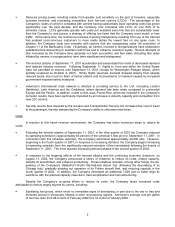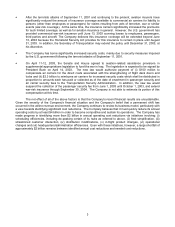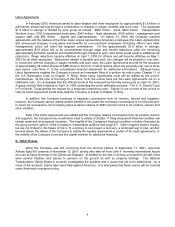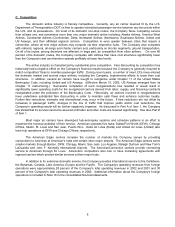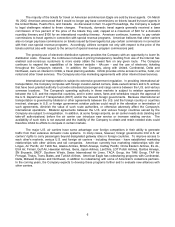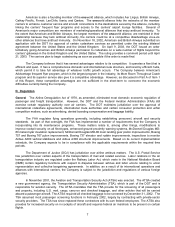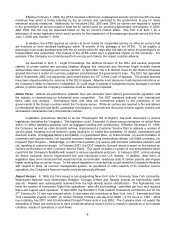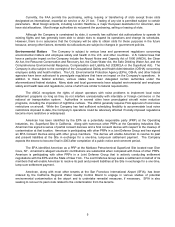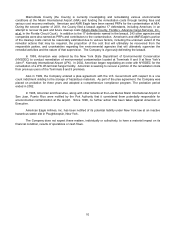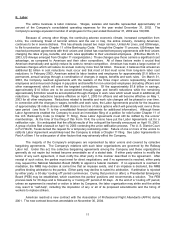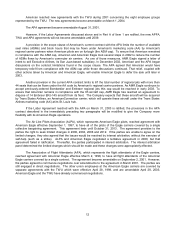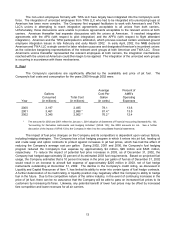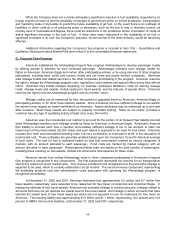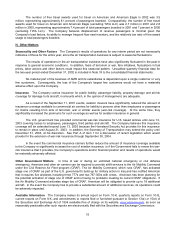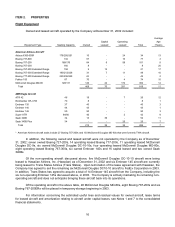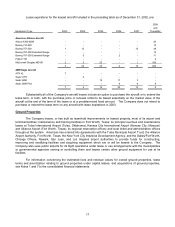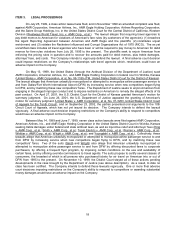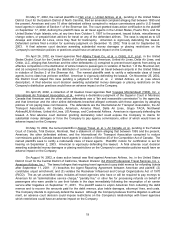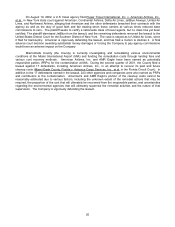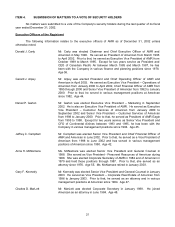American Airlines 2002 Annual Report Download - page 14
Download and view the complete annual report
Please find page 14 of the 2002 American Airlines annual report below. You can navigate through the pages in the report by either clicking on the pages listed below, or by using the keyword search tool below to find specific information within the annual report.12
American reached new agreements with the TWU during 2001 concerning the eight employee groups
represented by the TWU. The new agreements become amendable on March 1, 2004.
The APA agreement became amendable August 31, 2001.
However, if the Labor Agreements discussed above and in Part A of Item 1 are ratified, the new APFA,
TWU and APA agreements will not become amendable until 2009.
A provision in the scope clause of American’s current contract with the APA limits the number of available
seat miles (ASMs) and block hours that may be flown under American's marketing code (AA) by American's
regional carrier partners when American pilots are on furlough (the ASM cap). To ensure that American remained
in compliance with the ASM cap, American and American Eagle took several steps in 2002 to reduce the number
of ASMs flown by American’s commuter air carriers. As one of those measures, AMR Eagle signed a letter of
intent to sell Executive Airlines, its San Juan-based subsidiary. In December 2002, American and the APA began
discussions on the contract limitations found in the scope clause. The APA agreed that American would have
temporary relief from compliance with the ASM cap while those discussions continued. That relief, coupled with
other actions taken by American and American Eagle, will enable American Eagle to defer the sale until later in
2003.
Another provision in the current APA contract limits to 67 the total number of regional jets with more than
44 seats that can be flown under the AA code by American’s regional carrier partners. As AMR Eagle continues to
accept previously-ordered Bombardier and Embraer regional jets this cap would be reached in early 2003. To
ensure that American remains in compliance with the 67-aircraft cap, AMR Eagle has reached an agreement to
dispose of 14 Embraer ERJ-145 aircraft from its fleet. The Company expects that these aircraft will be acquired
by Trans States Airlines, an AmericanConnection carrier, which will operate these aircraft under the Trans States
Airlines marketing code (AX) at its St. Louis hub.
If the Labor Agreement reached with the APA on March 31, 2003 is ratified, the provisions in the APA
contract described in the immediately preceding two paragraphs will be modified to give the Company more
flexibility with its American Eagle operations.
The Air Line Pilots Association (ALPA), which represents American Eagle pilots, reached agreement with
American Eagle effective September 1, 1997, to have all of the pilots of the Eagle carriers covered by a single
collective bargaining agreement. This agreement lasts until October 31, 2013. The agreement provides to the
parties the right to seek limited changes in 2000, 2004, 2008 and 2012. If the parties are unable to agree on the
limited changes, they also agreed that the issues would be resolved by interest arbitration, without the exercise of
self-help (such as a strike). ALPA and American Eagle negotiated a tentative agreement in 2000, but that
agreement failed in ratification. Thereafter, the parties participated in interest arbitration. The interest arbitration
panel determined the limited changes which should be made and these changes were appropriately effected.
The Association of Flight Attendants (AFA), which represents the flight attendants of the Eagle carriers,
reached agreement with American Eagle effective March 2, 1998, to have all flight attendants of the American
Eagle carriers covered by a single contract. The agreement became amendable on September 2, 2001. However,
the parties agreed to commence negotiations over amendments to the agreement in March 2001. The parties are
still engaged in direct negotiations. The other union employees at the American Eagle carriers are covered by
separate agreements with the TWU which were effective April 28, 1998, and are amendable April 28, 2003.
American Eagle and the TWU have already commenced negotiations.


